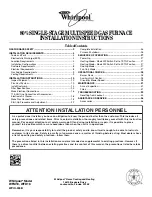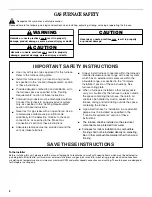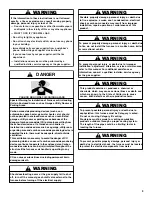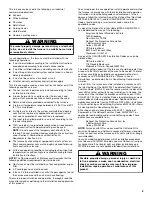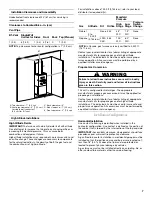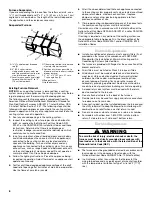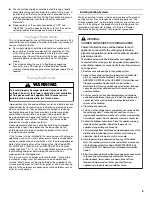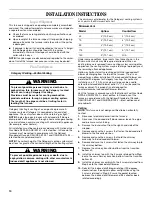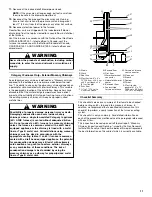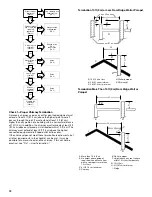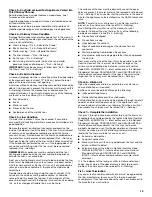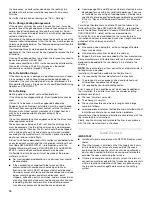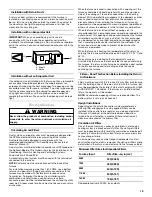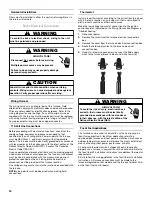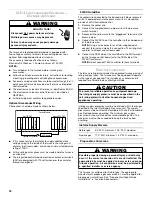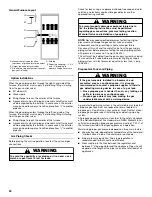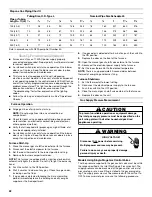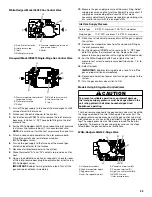
9
■
The line voltage supply should be routed through a readily
accessible disconnect located within sight of the furnace. A
junction box on the furnace side panel is provided for line
voltage connections. See the Wiring Connection Diagram in
the “Troubleshooting” section for specific connection
information.
■
Proper polarity of the supply connections (“HOT” and
“NEUTRAL”) must be observed to be sure that the control
system provides the damage avoidance intended.
Gas Supply Requirements
This unit is equipped for use with Natural gas. A conversion kit is
required for use with propane. To order the correct conversion kit,
see your local distributor.
■
Gas supply piping should be installed in accordance with
local, state and national codes and the regulations of the
utility. Piping must be of adequate size to prevent undue
pressure drop. Consult the local utility or gas supplier for
complete details on special requirements for sizing gas
piping.
■
If local codes allow the use of a flexible gas appliance
connector, use a CSA design-certified outdoor flexible
stainless steel appliance connector or rigid gas supply line as
needed.
Venting Requirements
Improved construction and additional insulation in buildings have
reduced heat loss by reducing air infiltration and escape around
doors and windows. These changes have helped in reducing
heating/cooling costs but have created a problem supplying
combustion and ventilation air for gas-fired and other fuel
burning appliances. Appliances that pull air out of the house
(clothes dryers, exhaust fans, fireplaces, etc.) increase the
problem by starving appliances for air.
House depressurization can cause back drafting or improper
combustion of gas-fired appliances, thereby exposing the
building occupants to gas combustion products that could
include carbon monoxide.
If this furnace is to be installed in the same space with other gas
appliances, such as a water heater, ensure there is an adequate
supply of combustion and ventilation air for the other appliances.
Refer to the latest edition of the National Fuel Gas Code NFPA
54/ ANSI Z223.1 (Section 5.3), or CAN/CSA B149 Installation
Codes (Sections 7.2, 7.3, or 7.4), or applicable provisions of the
local building codes for determining the combustion air
requirements for the appliances.
This furnace must use indoor air for combustion. It cannot be
installed as a direct vent (for example, sealed combustion)
furnace. Most homes will require outside air be supplied to the
furnace area by means of ventilation grilles or ducts connecting
directly to the outdoors or spaces open to the outdoors such as
attics or crawl spaces.
Existing Venting Systems
When an existing furnace is removed or replaced, the original
venting system may no longer be sized to properly vent the
attached appliances. An improperly sized venting system can
result in the spilling of flue products into the living space, the
formation of condensate, leakage, etc. See the “Carbon
Monoxide Poisoning Hazard” for proper test procedure.
Goodman 51
To avoid property damage, personal injury or death,
sufficient fresh air for proper combustion and ventilation
of flue gases must be supplied. Most homes require
outside air be supplied into the furnace area.
WARNING
WARNING:
CARBON MONOXIDE POISONING HAZARD
Failure to follow the steps outlined below for each
appliance connected to the venting system being
placed into operation could result in carbon monoxide
poisoning or death.
The following steps shall be followed for each appliance
connected to the venting system being placed into operation,
while all other appliances connected to the venting system are
not in operation:
1. Seal any unused openings in the venting system.
2. Inspect the venting system for proper size and horizontal
pitch, as required in the National Fuel Gas Code,
ANSI Z223.1/NFPA 54 or the CSA B149.1, Natural Gas and
Propane Installation Codes and these instructions.
Determine that there is no blockage or restriction, leakage,
corrosion and other deficiencies which could cause an
unsafe condition.
3. As far as practical, close all building doors and windows
and all doors between the space in which the appliance(s)
connected to the venting system are located and other
spaces of the building.
4. Close fireplace dampers.
5. Turn on clothes dryers and any appliance not connected to
the venting system. Turn on any exhaust fans, such as
range hoods and bathroom exhausts, so they are operating
at maximum speed. Do not operate a summer exhaust fan.
6. Follow the lighting instructions. Place the appliance being
inspected into operation. Adjust the thermostat so
appliance is operating continuously.
7. Test for spillage from draft hood equipped appliances at the
draft hood relief opening after 5 minutes of main burner
operation. Use the flame of a match or candle.
8. If improper venting is observed during any of the above
tests, the venting system must be corrected in accordance
with the National Fuel Gas Code, ANSI Z223.1/NFPA 54
and/or CSA B149.1, Natural Gas and Propane Installation
Codes.
9. After it has been determined that each appliance connected
to the venting system properly vents when tested as
outlined above, return doors, windows, exhaust fans,
fireplace dampers and any other gas-fired burning
appliances to their previous conditions of use.

